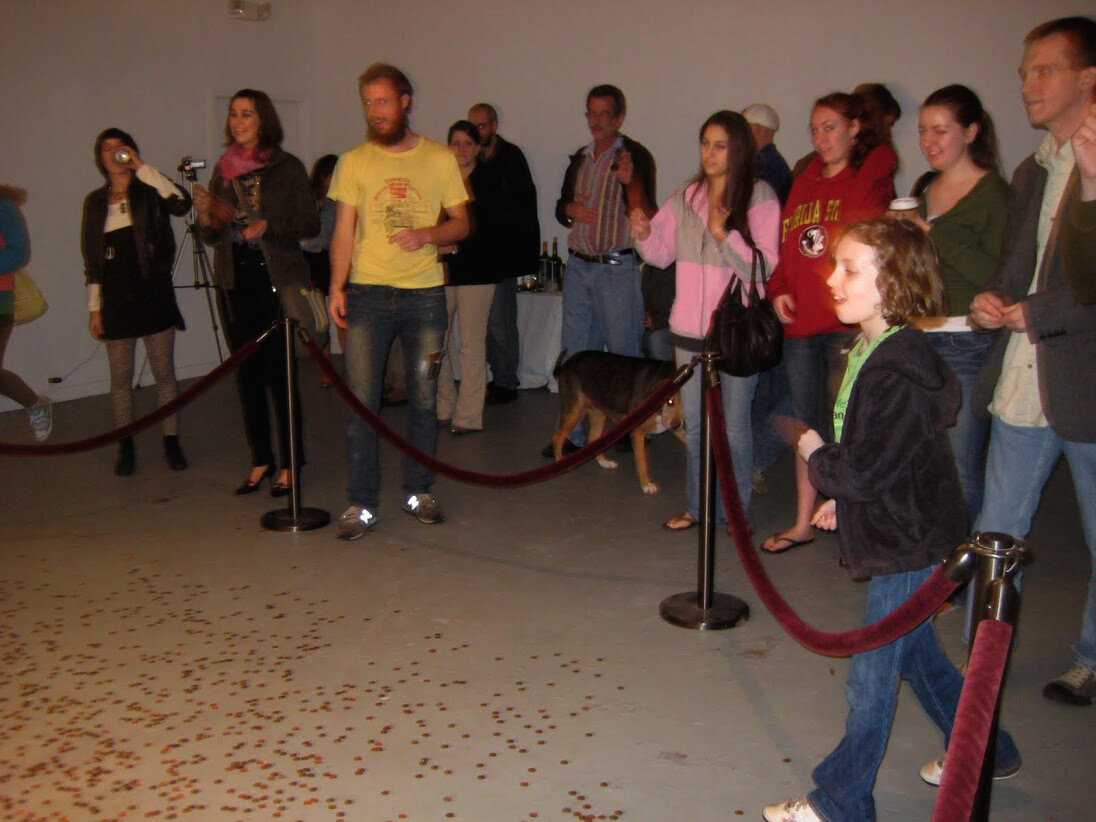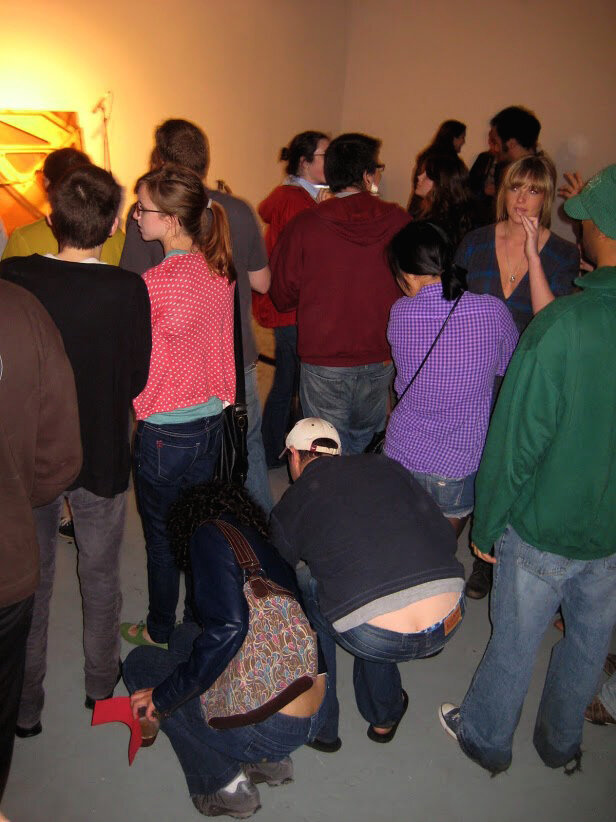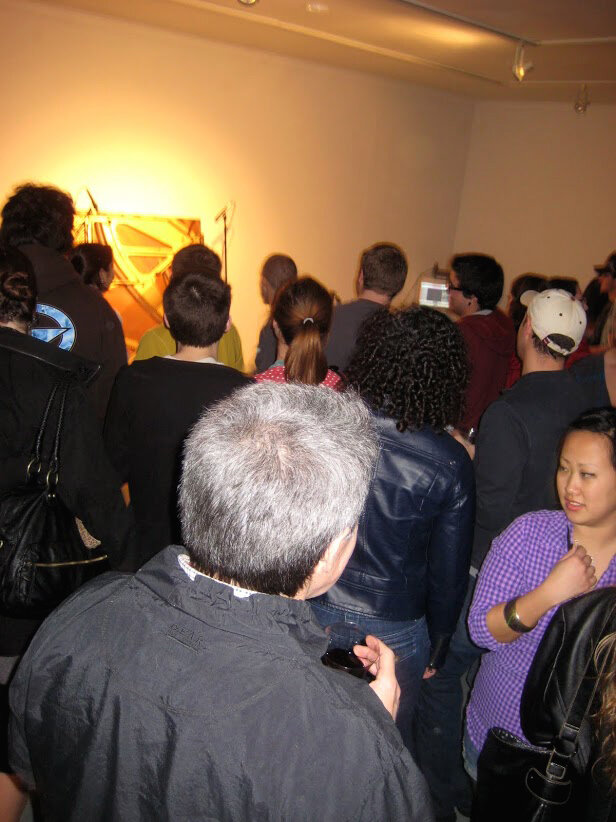Cage’s Compounding Fountain: for Audience and Altered Piano
On Friday, February 5, 2010, at the Big Bend Contemporary Gallery in Tallahassee FL, Windham Graves, Hunter Jonakin, and I presented a one night performance of Cage’s Compounding Fountain: for Audience and Altered Piano.
The piece consisted of, on the one hand, the fountain, which comprised the strings and soundboard of an upright piano, two dynamic microphones, two computers, a mixing board and a set of speakers, and, on the other hand, the audience. Stanchions, running in an arc twelve feet out from the piano, separated these components. The audience was invited to throw coins at the piano, the sound of which was recorded by one of the two computers. After the first half-hour, that recording was played back, while the second computer recorded. In the third half-hour, the recording was again compounded, and so on, such that in each successive half-hour, all the preceding half-hours could be heard simultaneously, along with what was happening live. The performance ran from 6:00pm to 10:00pm.
As many people do not carry coins, pennies and quarters were available for exchange (though the quarters went largely untouched). All coins that rebounded beyond the stanchions were free to pick up, but those that remained inside were to be left where they fell.
The act of throwing coins at the piano was, for all who tried it, wonderful fun, while for some it proved practically addictive. This was amply evidenced in the first half hour, even before the crowds formed, as children and adults alike chased after the rebounds for another throw. Throughout the evening, this strange, often transformative phenomenon continued. Serious-minded people, whether cynical adults or jaded adolescents, would enter, skeptical of the noise, or crowds, or art, disapproving even, if their scowls were any indication. They would stand back for a while, watching, and some would leave, but most would find a nickel or dime in a pocket or change purse and give it a try. This was all it took. One craggy faced, heavily mustached fellow, having thrown with good result the dime his wife fished out of her handbag for him, flashed the most delightedly boyish grin, made all the more delightful for its contrast with his preceding demeanor.
Delight was the typical response, primarily motivated, it seemed, by a visceral pleasure in manifest causality. This response was, in some, extreme. One fellow, beaming, jumped up and down and clapped with glee, exactly like a small child. There was, however, one deeply negative response, although the motivation for it was not perfectly clear. An older woman sat and watched the performance for some time before suddenly realizing what the crowd was throwing. “Pennies!” she exclaimed, and again, louder, to be heard over the din, “Pennies!” This, evidently, was not all right. She made several other comments that we did not quite follow, but which were clearly disapproving. The sense of it seemed to be that it was in some way disrespectful of money to throw it, a kind of capitalist sacrilege. It is possible that what she intended was that it was disrespectful of art to associate it with money, which is certainly a familiar sentiment, though, in truth, no less strange. She left then, only to return a moment later to add, “Arrogant!”
Though somewhat outside the ordinary, this response does highlight one of the more interesting aspects of the performance. The pleasure in the action (and reaction) of throwing coins profoundly altered people’s relationship with them. Even as a child, I have never seen such satisfaction in the finding of a penny. “Revaluing The Penny,” we decided our slogan should be. At times in the press around the exchange table, pennies were dropped in counting. Having lost one or two in such an accident, one girl commented, “It’s only a penny,” to which Windham replied, “It’s only a penny until you haven’t got any more.” Sure enough, moments later, having thrown her last, she was on the floor looking for strays. Dissatisfied with the few she found, she was soon back to buy another hundred.
There were several different approaches to throwing. The majority of the audience threw their coins individually or on twos and threes, at a relatively even pace. Some chose to throw fifty or a hundred at once (producing an astonishing din, often followed by a burst of applause). One or two, with a decided air of affluence about them, threw in small, negligent handfuls, equally amused by a good hit or a miss. On the whole, people seemed astonished by how fast fifty or a hundred pennies went.
As the evening progressed into its final hour, the crowd changed somewhat, growing on the whole younger and more raucous. Throughout the evening the rule benders had been reaching over or tucking their feet under the stanchions to fish out coins, but in the last hour this behavior grew much more frequent. There were also several rule flaunters who would boldly step inside the stanchions to take coins by the handful. The audience response to this ranged from amused to mildly scandalized, but tended mostly toward disapproval.
Throughout the evening the crowds ebbed and swelled at a surprisingly even pace, and there was no diminution of this rhythm toward the end of the evening. Just shy of 10:00pm, at a low point in the crowd, we turned off the recording and closed the doors. $113.66, almost entirely in pennies, remained on the floor.
The recording is itself an interesting artifact, though as there was no third recording device to document the whole four-hour performance, we only have the last, most heavily layered, half-hour. The sounds produced over the course of the evening developed through several phases. The first half-hour consisted primarily of sporadic bursts of sound, with the occasional chord or run emerging from the chance noise (always a pleasing surprise). At this stage, the sounds of the coins hitting the strings or sounding board were mostly distinct, separated by sometimes lengthy silences. The crowd was not yet dense enough to contribute much of its own noise to the performance, and so the piano dominated.
In the second half-hour playback began. Situating the speakers behind the piano not only concealed them, but also enabled the piano’s soundboard to pick up, amplify, and naturalize the recorded tones, rendering them indistinguishable from those newly produced.
While the crowd remained intermittent, this resulted in the distinct impression that the piano was, at times, generating sound of its own accord. As the crowds and rate of throw increased, however, and as the recording continued to compound, it became difficult to differentiate the often almost simultaneous sound of a newly thrown coin from that of one thrown an hour or two previously. Furthermore, the crowd was soon large enough to contribute its own low, continuous murmur, punctuated by occasional exclamations. The result was as anticipated—cacophony.
In the final hour, an interesting sonic phenomenon developed out of the recording process: a very low-pitched throbbing began, a sound entirely unlike any a piano could make. This throbbing was primarily due to additive effects in the re-recording, but it was encouraged by two factors: first, that lower tones predominated because the higher, shorter strings were less frequently struck, and second, that the lower strings reverberated for longer than the higher ones.
Despite the volume, which by the end of the evening was profound, a number of audience members were interested in discussing at length the conceptual purposes of the performance. The topics of these discussions ranged from chance processes, to interactivity, to technology in art, but focused mostly on economic issues, on the idea that the generative moment in art production does not lie with the artist or with the audience, but specifically in the moment of economic exchange—the only partly tongue-in-cheek notion that throwing money at it, makes it art.
Quite a few people asked where the money would go after the performance (the answer being, to offset costs, which we almost managed to do). There was an intimation in the tone of these inquires that suggested our profiting from the performance would be, in some way, inappropriate, which of course highlights the ongoing unease between art and commerce.
In our instance, this unease may have been compounded by confusion between performance and object-based art. The performance was held in a gallery space typically devoted to traditional art objects, where the experience of viewing art is free (virtually nothing is ever sold). And yet participation in our production was (at least for those unwilling to collect the rebounds) not free. This money went neither to purchase an object, nor for admission to the performance; the expenditure was uncategorized, and therefore questionable.
Several people inquired if the piece was actually by John Cage; we explained that it was not, that the title was an acknowledgment of his precedent and a suggestion that the ideas of preceding generations, compounded over time, are the fountain from which contemporary art draws. Most seemed satisfied with this explanation, but several were strangely disapproving, as if we were falsely claiming the legitimacy of Cage’s name, like a composer who writes a piece and tries to pass it off as Bach.
Regardless, it was gratifying to see how well the piece lent itself to interpretation—almost as gratifying as it was to see the pleasure with which the audience participated.
Were we to present a second performance of Cage’s Compounding Fountain, the only major revision we would make is to procure a third recording device to document the developing sound over the course of the entire evening.
With slight adjustments to the recording and playback automation, this setup could be modified for a long-term installation.
The Count: 10,136 pennies, 50 nickels, 73 dimes, 10 quarters





